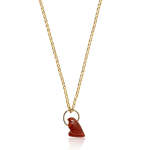

Egyptian
Carnelian Falcon Pendant, Egyptian, Middle Kingdom to New Kingdom, circa 2000 - 700 BC
Carnelian and gold
Length of amulet: 1 cm
Length of chain: 18 inches (adjustable to 16 inches)
Length of chain: 18 inches (adjustable to 16 inches)
An ancient Egyptian carnelian falcon amulet, circa 2000-700 BC, suspended from a modern 18 carat gold loop and chain. The amulet is carved in the form of a standing falcon.
An ancient Egyptian carnelian falcon amulet, circa 2000-700 BC, suspended from a modern 18 carat gold loop and chain. The amulet is carved in the form of a standing falcon.
Provenance
Private collection, Japan, 1980With Galerie Nefer, Zurich, acquired in Japan in the 1990s
Private collection, Aarau, Switzerland, until 2015, thence by descent
Private collection, Switzerland, acquired in 2018
Exhibitions
On Loan: Antikenmuseum Basel & Sammlung Ludwig, 1998 – 2022Literature
Egyptian amulets were believed to possess positive properties that could be magically bestowed upon the owner. This magical power could be derived from several elements of the amulet: the material, colour, shape, decoration, and the object that the amulet was intended to represent. Amulets could be worn with other pieces of jewellery or sewn into clothes.Falcons are often associated with the ancient Egyptian sky god Horus, though various deities and the pharaoh himself could assume a falcon form. The identification of the deity represented is even harder in the case of amulets (Andrews 1994, 27-28). For a similar carnelian example dated to the Middle Kingdom, see The Metropolitan Museum of Art, New York, acc. no. 08.200.42a.
Publications
A. Wiese, Ägypten – Augenblicke der Ewigkeit: unbekannte Schätze aus Schweizer Privatbesitz, Mainz, 1997, p.84-5, ill. d (part).

